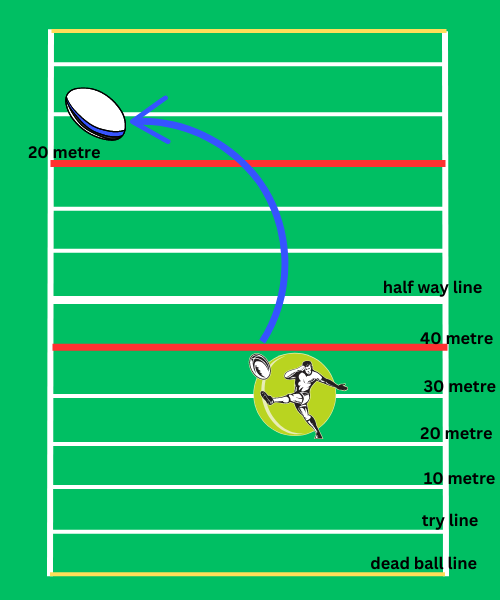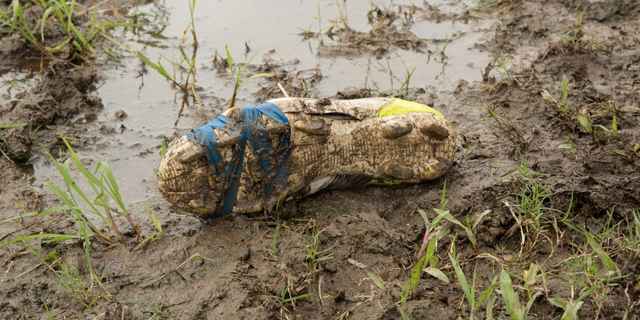The 40/20 kick in rugby league is a tactical kick that aims to bounce the ball into touch within the opposition’s 20-meter area.
The first rule is that the kicker must be behind the attacking team’s own 40-meter line.
The second rule is that the ball must hit the ground before it goes over the sideline.
A successful kick means that the attacking team regains possession with a scrum. This gains valuable field position.
This diagram shows the league rule in action:

When Is Taking A 40/20 Kick A Good Option?
A 40/20 kick is more likely to be successful if the defending team’s wingers and fullback are positioned relatively close to the attacking team.
This leaves open space near the sideline in the opposition’s 20-meter area. It also means that the defenders most likely to intercept the ball have to turn and rush back.
If a defender catches the ball, the 40/20 attempt was the wrong option! As it’s a risk, this kick is only attempted in certain scenarios.
It’s more likely to be tried when the attacking team is behind on the scoreboard and there isn’t much time left in the game.
It may also be tried when the kicker’s team is struggling to make progress through running and passing plays. A successful 40/20 can help shift momentum in the attacking team’s favor.
When Is It A Bad Option?
The effectiveness of a 40/20 kick depends on the skill and confidence of the kicker.
If the kicker hasn’t shown the ability to execute this type of kick accurately and consistently, then it’s probably a poor option in a close match.
Weather and pitch conditions can also make it a bad decision. A strong cross-wind can blow the ball out before bouncing, or blow it in so that it bounces downfield without going into touch.
Rain and a muddy field surface also make the kick more difficult to execute.

What Do Teammates Do When Someone Executes A 40/20 Kick?
Teammates need to anticipate what the kicker is doing and react to a 40/20 kick.
They can do this by recognizing the kicker’s body language and understanding the game situation. Is the team behind with minutes to go? Everyone should watch out for a 40/20.
The wingers and forwards should chase the kick toward the touchline as soon as it leaves the kickers foot. This puts pressure on the defending team.
Other teammates should move sharpish into the opposition’s half and prepare for the next phase of play.
This may involve getting into position for a scrum or forming a new attacking line once possession is regained.
The other vital aspect is communication. This includes calling out the kick, directing chasers, and organizing the team for the next phase of play.
Setting up for the next phase of play
If the 40/20 kick is successful, the attacking team will regain possession with a scrum in the opposition’s 20-meter area.
Teammates should quickly get into position and be prepared to launch an attacking set of tackles to capitalize on the field position.
Reacting to an unsuccessful kick
An unsuccessful 40/20 kick either does not find touch or is caught by the opposition.
When this happens, teammates should quickly transition to defense. Their role now is to regain possession or prevent a counterattack.
How Do Defenders Neutralize A 40/20 Kick?

Defenders should look for cues from the kicker’s body language or the game situation.
Recognizing when a 40/20 kick might be attempted can help defenders react more quickly.
The defending fullback and wingers should maintain appropriate positioning to cover potential 40/20 kicks.
This might involve positioning themselves deeper in the field or closer to the touchline to cut off the angle for a successful kick.
If a defender think that a 40/20 is about to happen, they must communicate that to their teammates. In particular, a shout must go out to the fullback and wingers.
Typically, the defending winger or fullback sprints sprinting towards the sideline to try to catch the ball before it goes out.
If a clean catch isn’t viable, the next best option is to force it back into the field of play.
If a defender manages to catch or gather the ball, their priority is to keep possession. They should hold the ball securely and protect it from being stripped by the attacking players.
The next step for defenders is to make the choice to counterattack or play the ball.
Counterattack or play the ball
After securing possession, the defender can initiate a counterattack by running the ball back towards the opposition.
The other option is to play the ball to a teammate to start a new set of tackles. The rest of the team prepare for attacking play.
More About Kicking
The 40/20 kick is long and aimed forward at a diagonal trajectory. Cross-field kicks in league tend to be long and lateral but not as high.
In general, high kicks to put opposition wingers and fullbacks under pressure are at a higher trajectory. In contrast, grubber kicks in league are scudded along the ground.
Check out our article on kicking in rugby league for a rundown of eight types of kicks.